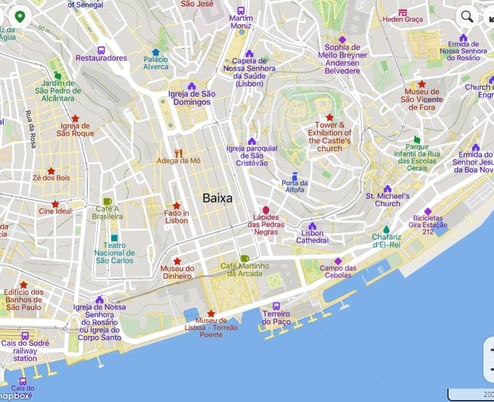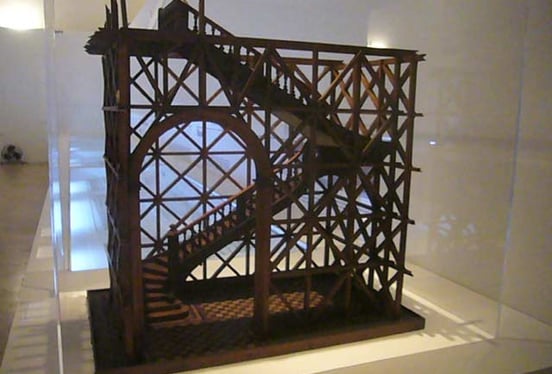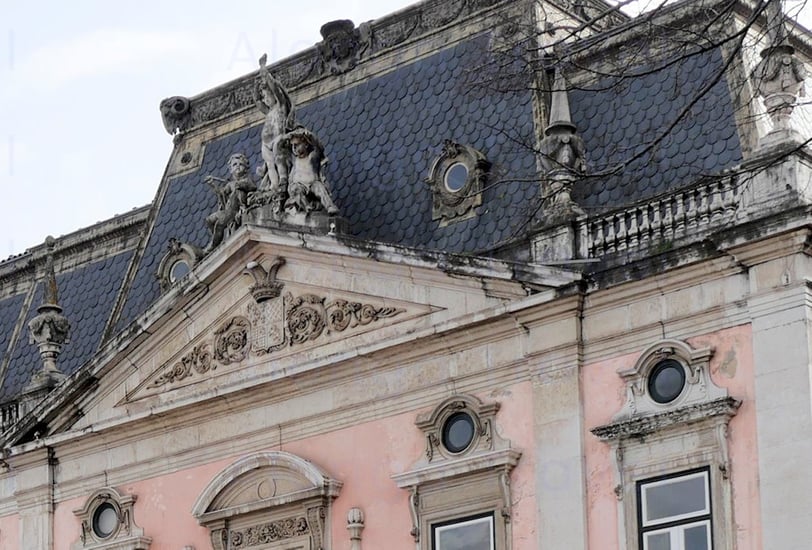Read about alluring Pombaline Architecture that emerged in the 18th century. It was born as a part of significant changes in urban planning in Lisbon following the devastating Lisbon Earthquake of 1755.
This Pombaline style of architecture was introduced by Marquis de Pombal in Lisbon among other Pombaline reforms. Read more about fascinating Pombaline reforms, in my other post.
One of the interesting features of Pombaline buildings was a new earthquake-proof buildings technique - Pombaline Cage. There were also other new elements and design styles as well, which I talk about in this post.


Pombaline Architecture: Unique Style Emerged from Reforms
Pombaline downtown Lisbon or Baixa Pombalina
Pombaline downtown, located in the historic center of Lisbon, is the best example of the Pombaline style, with its carefully planned streets and spacious boulevards.
It is located in the area north of Praça do Comércio, between Cais do Sodré and Alfama district beneath Lisbon Castle. It is also boarded by Avenida da Liberdade.
Baixa Pombalina was born out of necessity after the devastating Lisbon Earthquake of 1755, which left much of the city in ruins. Under the leadership of the Marquis of Pombal, the district was carefully designed and reconstructed to ensure the safety, functionality, and aesthetic appeal of the new city center.


Pombaline downtown or Baixa Pombalina


1. © OpenStreetMap, Mapbox and Mapcarta


2.The old Topographic map of the ruined city of Lisbon and of the newly designed by architects Eugénio dos Santos Carvalho and Carlos Mardel, Baixa Pombalina. This is a faithful photographic reproduction of a two-dimensional, public domain work of art.
Grid-like street layout of Lisbon
The Marquis of Pombal, with the assistance of architects and military engineers Eugénio dos Santos, Manuel da Maia and Elias Sebastião Pope, introduced a revolutionary for Portugal grid-like street layout for Baixa Pombalina.
The grid-like layout of Baixa Pombalina incorporated wide boulevards that intersected at right angles. This design created a sense of order and made it easier for people to navigate through the city. The wide boulevards in Baixa Pombalina had plenty of room for both people walking and vehicles, making it easier for everyone to get around. This created better accessibility and made moving around the area much more convenient.
The grid-like layout of Baixa Pombalina was inspired by Enlightenment ideals and urban planning concepts of the time.
The Enlightenment and urban planning
The Enlightenment was a period in history characterized by the emphasis on reason, logic, and progress. In the context of urban planning, Enlightenment thinkers believed in creating organized and functional cities that would improve the lives of their inhabitants.
And that is exactly what Pombaline architecture provides.
The architecture of Baixa Pombalina is a unique blend of Neoclassical and Pombaline styles.
Baixa Pombalina was not only a physical reconstruction project but also an opportunity to improve the quality of life for the inhabitants of Lisbon. The Marquis of Pombal implemented regulations for public health and sanitation, ensuring better living conditions for the residents. Read more
The district became a center of commerce, trade, and cultural exchange. The grand Rua Augusta, the main street of Baixa Pombalina, served as a vibrant commercial hub, lined with shops, cafes, and theaters. It became a symbol of the city's resilience and revival, attracting locals and visitors alike.
Today, Baixa Pombalina is a lively district with historical landmarks, famous squares, and vibrant shopping streets. Tourists love its beautiful buildings and energetic atmosphere, a lovely blend of the past and present.
Baixa was designed not only with a grid-like street layout and wider boulevards. All buildings started being constructed with new sturdy materials and construction techniques, such as the famous Pombaline Cage.


Baixa Pombalina area of Lisbon
Pombaline Cage
Pombaline Cage, also known as Gaiola Pombalina, is the building seismic-resistant construction technique that was developed during the reconstruction of Lisbon, following the 1755 Lisbon earthquake. It involves reinforcing a masonry structure with an internal wooden cage.
This construction method was used during the reconstruction of Lisbon Baixa, the downtown area of Lisbon.
The Pombaline Cage was named after the Marquis of Pombal, makes buildings more flexible and resistant to earthquakes. It uses wooden frameworks and flexible connections, acted as a shock absorber, allowing the buildings to sway during seismic events and minimizing damage.
Before the Pombaline Cage, buildings in Lisbon were mostly made of stone or masonry, which didn't hold up well during earthquakes.
Marquis de Pombal recognized the need for a stronger construction method that could withstand future earthquakes. He implemented strict building regulations that required structures to be built with sturdy materials and specific design features to withstand future earthquakes.
Pombaline Cage uses a wooden framework that creates a grid-like pattern inside the walls of the buildings. Metal connectors, like iron straps, are used to connect the wooden beams and columns, allowing them to move and absorb the energy produced by earthquakes.
Pombaline Cage has several advantages when it comes to earthquake resistance. The wooden framework allows the buildings to sway during earthquakes without collapsing. This helps to distribute the seismic forces evenly throughout the structure and prevents stress from concentrating on specific points.
The wooden framework is also lighter than solid masonry walls, reducing the overall weight of the buildings. This weight reduction improves the structural integrity and stability of the constructions.
The implementation of the Pombaline Cage technique was a significant advancement in building construction and earthquake resilience. It not only allowed for the reconstruction of Lisbon, but also influenced architectural practices in other earthquake-prone regions around the world.
Today, the Pombaline Cage is recognized as an important feature of Lisbon's buildings. Many structures in the city's Baixa Pombalina district, which was rebuilt using this technique, still have the characteristic wooden framework within their walls.
The Pombaline Cage showcases the creation of a safer and more resilient city of Lisbon and later – all of Portugal. Its innovative design and earthquake-resistant properties have contributed to the preservation of Lisbon's and Portuguese architectural heritage, allowing future generations to appreciate the city's and country's history and advancements in building construction.
In addition to grid-like planning, use of sturdy materials and Pomaline Cage, Marquise de Pombal's architects introduced a new style of buildings—Pombaline buildings.


Wooden carcass of Pombaline cage. Galinhola, CC BY-SA 3.0 <https://creativecommons.org/licenses/by-sa/3.0>
One of the goals of the Pombaline Style was to create a unified and harmonious urban environment. The buildings within the reconstructed areas of Lisbon were designed to have a uniformed appearance following the regulations and guidelines set forth by the Marquis of Pombal.
This led to the creation of a unique style of buildings in Lisbon—Pombaline buildings.
Pombaline buildings in Lisbon
Pombaline buildings are 3-4 story structures with ground floor arcades, first floor balconies, and an attic, with simple and symmetrical facades and some decorative elements, including azulejos. The overall design is consistent, but the decorative elements on the façade vary based on the building's importance and purpose.
The design typically follows a three to four-story structure, with the ground floor reserved for commercial spaces and the upper floors used for residential purposes. Large storefront windows on the ground floor invite pedestrians into shops and businesses. The upper floors have regularly spaced windows that align with the overall symmetry of the building.


A row of Pombaline buildings in Lisbon
Ornamental Elements of Pombaline buildings in Lisbon
While the Pombaline Style prioritizes functionality and simplicity, it also incorporates decorative elements to add visual interest.
One prominent decorative feature found in Pombaline buildings is the use of azulejos, the typical Portuguese ceramic tiles. Azulejos cover both the façades and interiors of buildings, adding a touch of decoration a functionality.
Azulejos often depict intricate geometric designs, floral motifs, or scenes from history and mythology. They serve as both decorative elements and a cultural representation of Portugal's rich tradition of tile craftsmanship




Azulejos are also a practical thermos insulating material. Thermal insulation systems help buildings stay at comfortable temperatures. They prevent heat loss and make walls work better throughout the year. In summer, insulation keeps building interior cooler. In winter, insulated azulejos walls help keep the cold air out.
In Pombaline architecture, using azulejos adds beauty and cultural importance to the overall look.
In addition to azulejos, Pombaline buildings incorporated various other decorative elements to enhance their visual appeal.
Balconies and Ironwork
Pombaline buildings often featured balconies with intricate ironwork. These balconies added a touch of elegance to the façades. Not only they made the buildings look more beautiful, but they also had obviouse practical uses.
The patterns on the ironwork varied from simple and delicate to very detailed and elaborate, which showed off the skills and craftsmanship of ironworkers.


Beautiful black wrought iron balconies on a beige Pombaline building


Cornices and Molding
Cornices and molding were used to embellish the upper parts of the buildings.
Cornice is a horizontal structure that was added to old buildings to direct rainwater away. It is also used as a decorative element on the outside of buildings and inside residential buildings, similar to crown mounding. It can be seen in Pombaline buildings in Lisbon.
These decorative elements were typically found at the roofline, window surrounds, and doorways, making them look elegant and classy.


White decorative cornices on a Pombaline building, covered with green patterned azulejos


White decorative moldings over the door and windows of a pink Pombaline style building
Pilasters and Columns
Pombaline buildings sometimes incorporated pilasters and columns into their architectural design. These vertical elements, often made of stone or stucco, were used to create a sense of rhythm and proportion. They added a touch of grandeur to the buildings and evoked classical architectural influences.


Ornate pink Pombaline style building with columns over the door and plastered decorations over windows


Sculptures and Statues
Sculptures and statues were occasionally used as decorative elements in prominent locations on Pombaline buildings. These sculptures often depicted figures from mythology, historical figures, or allegorical representations. They added a sense of artistry and symbolism to the architecture.
Ornate Doorways
The entrances of Pombaline buildings were often adorned with ornate doorways. These doorways featured intricate carvings, decorative motifs, and sometimes even elaborate ironwork. They served as focal points, welcoming visitors and adding character to the overall design.
These various decorative elements combined to create a visually appealing and sophisticated architectural style. The use of these embellishments added a touch of artistry, showcasing the attention to detail and craftsmanship present in Pombaline buildings.
Pombaline architecture is very unique because it is specific to Lisbon and Portugal in general! But, because it created widely-needed seismic-proof buildings, it started to get adopted in many other countries as well!
BTW, do you know two other architectural styles, that are also specific to Portugal?
First is Manueline architecture style, and second is Mudejar style, that was unique to both Portugal and Spain areas of Europe. I have another post about these styles of architecture.
FAQ
What are the characteristics of pombaline architecture?
This architectural style was characterized by structures with optional decorations, uniformly designed with wooden frameworks and flexible connections to withstand future seismic events. Read about the short list of key characteristics of Pombaline style here and the above post for a more detailed answer.


Sculputes and statues decorating pink Pombaline style buildings
Modern day flats and houses in Pombaline style
Here are a few examples of how the modern day historic flats and houses built in Pombaline style look now.
Interior of a historic Pombaline building
Here is one example of interior decoration of a Pombaline style flat in Lisbon . Look at this beautiful use of interior azulejos in a modern flat. Someone is very lucky to have their bathroom looking this way, what o you think?:)
And here is another example on how the upper moldings look in that same historic building. Simply beautiful!
Would you like to see many beautiful different Pombaline buildings at once? Just get into public transport somewhere in Portugal for un official tour. Tram 28 goes on the best Lisbon's route for that, and you will enjoy many different buildings!
Thank your for reading! I hope you learned something new about historic architecture of Lisbon.
Here is the link to read about other interesting topics about Portugal on my blog.
Let's connect on social media; the links are below in the footer.




